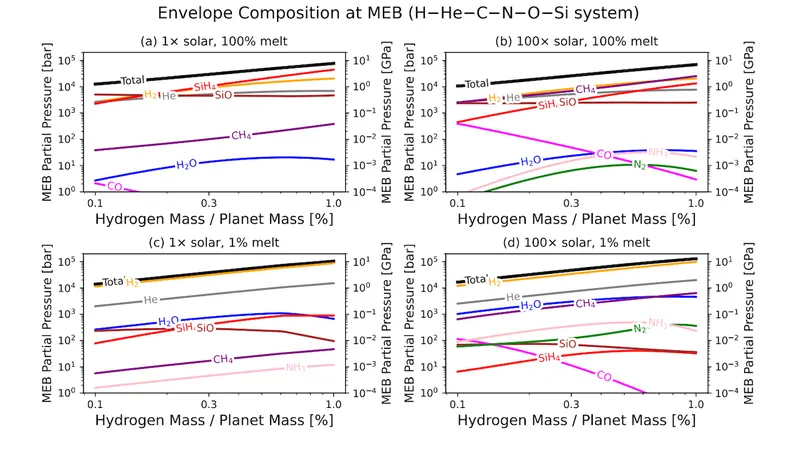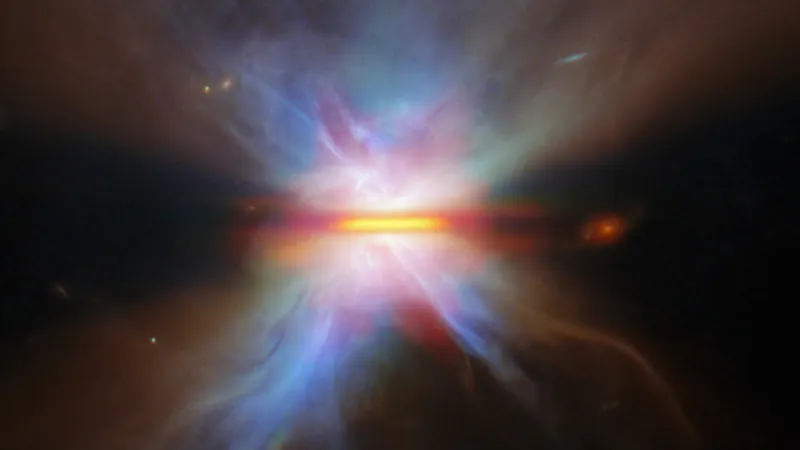
Unlocking the Secrets of Sub-Neptunes: How Magma Oceans Influence Atmospheres
2025-09-01
Author: Nur
The James Webb Space Telescope is revolutionizing our understanding of sub-Neptune planets by characterizing their atmospheres. One fascinating aspect under investigation is the presence of magma oceans, which can significantly change the chemical make-up of these planets' envelopes and atmospheres.
Magma Oceans: A Game Changer for Atmospheric Chemistry
At extreme depths known as the magma ocean-envelope boundary (MEB), which surpasses 10 kbars of pressure, gas behaviors deviate from theoretical expectations. This real gas behavior's impact on chemical equilibria has mostly gone unexplored, until now.
Diving into the Chemistry of TOI-421 b
In a groundbreaking study, researchers have focused on TOI-421 b, a hot sub-Neptune likely to feature a magma ocean. They analyzed the chemical equilibrium between magma and gas using advanced equations of state for elements like hydrogen, helium, carbon, nitrogen, oxygen, and silicon.
Their findings reveal that hydrogen and nitrogen are more soluble in magma than other elements like helium and carbon, suggesting a complex interplay of chemistry beneath the planet's surface.
The Role of Silicon in Sub-Neptune Atmospheres
With experiments fitting real gas equations to silicon hydride (SiH4), it becomes clear that under a fully molten mantle, SiH4 predominates at the MEB when metallicity is at standard solar levels. However, in metallicity-rich environments—100 times that of the sun—methane (CH4) takes over.
Lower melting fractions in the mantle influence both the abundance of silicon in the atmosphere and the solubility of hydrogen and helium, leading to atmospheres rich in H2 and He.
Atmospheric Chemistry and Indicators of Magma Oceans
By examining equilibrium chemistry through various atmospheric pressures, researchers found that condensation of beta-quartz clouds depletes silicon-bearing gases. Still, SiH4 remains prominent at solar metallicity. Interestingly, SiH4 to CH4 ratios vary based on mantle melt fraction, pointing to deeper geological processes.
Moreover, the interactions between SiH4 and CH4 offer insights into the planets' metallicity and magma ocean presence. Atmospheres rich in H2 and He but low in SiH4 and CH4 (less than 5%) could hint at a minimal influence of magma oceans on sub-Neptunes.
Conclusion: A New Era of Planetary Exploration
This new research opens exciting avenues for understanding sub-Neptune atmospheres. As the James Webb Space Telescope continues its observations, we may soon unlock even more mysteries about these intriguing worlds and their potential magma oceans.






 Brasil (PT)
Brasil (PT)
 Canada (EN)
Canada (EN)
 Chile (ES)
Chile (ES)
 Česko (CS)
Česko (CS)
 대한민국 (KO)
대한민국 (KO)
 España (ES)
España (ES)
 France (FR)
France (FR)
 Hong Kong (EN)
Hong Kong (EN)
 Italia (IT)
Italia (IT)
 日本 (JA)
日本 (JA)
 Magyarország (HU)
Magyarország (HU)
 Norge (NO)
Norge (NO)
 Polska (PL)
Polska (PL)
 Schweiz (DE)
Schweiz (DE)
 Singapore (EN)
Singapore (EN)
 Sverige (SV)
Sverige (SV)
 Suomi (FI)
Suomi (FI)
 Türkiye (TR)
Türkiye (TR)
 الإمارات العربية المتحدة (AR)
الإمارات العربية المتحدة (AR)